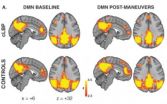(Press-News.org) A single genetic defect on the X chromosome that can result in a wide array of conditions — from learning and emotional difficulties to primary ovarian insufficiency in women and tremors in middle-aged men — occurs at a much greater frequency than previously thought, research led by the UC Davis MIND Institute has found.
The research is based on the first large-scale, multi-center newborn screening effort for the defect in the United States, conducted in a group of more than 14,200 male and female infants at three research university medical centers piloting a new infant screening test developed at UC Davis.
The study, "FMR1 CGG Allele Size and Prevalence Ascertained Through Newborn Screening in the United States," was led by Flora Tassone, professor-in-residence in the Department of Biochemistry and Molecular Medicine, and was conducted using blood spots obtained from infant heel pricks as part of the normal newborn genetic screening process. It is published online today in the journal Genome Medicine.
The investigators examined the prevalence of expanded alleles of the fragile X mental retardation 1 (FMR1) gene. Defects in FMR1 cause conditions as diverse as fragile X syndrome — the leading cause of intellectual disability and the leading known single-gene cause of autism — and a Parkinson's disease-like condition called fragile X-associated tremor/ataxia syndrome, or FXTAS. The term "fragile X" is used because of the altered appearance of the X chromosome among sufferers from the conditions.
"This study demonstrates that there is a higher frequency of mutations of the FMR1 gene across racial and ethnic groups than previously believed," said Randi Hagerman, medical director of the UC Davis MIND Institute and one of the world's leading experts on fragile X-related conditions. "It also demonstrates that newborn screening for fragile X mutations is technically feasible in a large-scale setting using the blood spot technique developed by Dr. Tassone."
The degree of disability from defects in FMR1 depends upon the number of repetitions of the sequence of the proteins cytosine-guanine-guanine (CGG) in the promoter region of the gene. The range of repeats in normal individuals is between six and 40. CGG repeats greater than 200 cause what is called the full mutation and fragile X syndrome. Fewer repeats — in the range of 55 to 200 — result in a variation called a premutation.
The current study found the estimated prevalence of the premutation to be 1 in 200 females, a finding somewhat greater than earlier estimates. However, it estimates the prevalence among males to be 1 in 400 — double what had previously been reported. The researchers said that the sample size in the current study was not great enough to estimate the true prevalence of the full fragile X mutation, currently estimated at between 1 in 2,500 and 1 in 8,000 females and 1 in 5,000 males.
While most people with the premutation appear normal, some individuals can have mild difficulties in childhood, such as such as learning problems or emotional difficulties including social anxiety and attention deficit hyperactivity disorder (ADHD), said Hagerman, a professor in the Department of Pediatrics. Individuals with the premutation also can suffer from FXTAS, which causes debilitating tremors, balance problems and dementia primarily in older men, and premature ovarian insufficiency in women.
Tassone, a researcher affiliated with the MIND Institute, is one of the world's leading experts on screening and identification of the FMR1 mutation. Her polymerase chain reaction (PCR)-based test used in the current study was described in January 2008 in the Journal of Molecular Diagnostics.
"This study shows that newborn screening for the FMR1 mutation is technically possible on a large scale," Tassone said. "However, the screening will identify far more carrier and gray-zone infants than those with a full fragile X mutation. As we now know that there may be clinical involvement with these individuals, such as FXTAS, we need to better understand the impact of identifying these mutations on families before widespread newborn screening can be instituted."
Hagerman said that the study is important because early intervention can be helpful for children with these mutations who experience developmental problems. In addition, a baby who is positive for the mutation will have other family members who also carry mutations. Genetic counseling is essential for the family members, in addition to treatment for the medical or psychiatric problems associated with the premutation or full mutation, she said.
###
Hagerman also is the director of the Fragile X Research and Treatment Center at the MIND Institute, which is engaged in multiple studies of targeted treatments for addressing the wide variety of difficulties arising from the genetic defect. Individuals interested in obtaining further information about or participating in fragile X-related research may contact Louise Gane at louise.gane@ucdmc.ucdavis.edu, 916-703-0238.
Funding for the study is provided by the Eunice Kennedy Shriver National Institute for Child Health and Human Development grant # HD02274; the American Recovery and Reinvestment Act grant # 3P30-HD002274-42S2; and grant # UL1 TR000002 from the National Center for Advancing Translational Sciences.
Other study authors include Ka Pou Iong, Tzu-Han Tong, Joyce Lo, Danh Nguyen, Yi Mu and Louise Gane, all of UC Davis; Elizabeth Berry-Kravis, Rush University Medical Center, Chicago; Jennifer Laffin, University of Wisconsin Department of Pediatrics, Madison; and Donald Bailey, RTI International, Research Triangle Park, N.C.
At the UC Davis MIND Institute, world-renowned scientists engage in collaborative, interdisciplinary research to find the causes of and develop treatments and cures for autism, attention-deficit/hyperactivity disorder (ADHD), fragile X syndrome, 22q11.2 deletion syndrome, Down syndrome and other neurodevelopmental disorders. For more information, visit mindinstitute.ucdavis.edu
Genetic defect causing fragile X-related disorders more common than thought
Study finds large-scale newborn screening for fragile X is 'technically possible'
2012-12-21
ELSE PRESS RELEASES FROM THIS DATE:
BGI reports the new findings reveal blood pressure dugs may treat chronic pain
2012-12-21
December 20, 2012, Shenzhen, China – An international team, comprised King's College London, Pfizer, BGI and other organizations, has explored the genetic variation related with pain sensitivity in the normal population, revealing some existing discovery that treatments for high blood pressure may also be used to treat chronic pain in the future. The latest study was published online in the international journal PLoS Genetics.
When the pain lasts a long time for six months or longer, it generally called chronic pain, one of the most costly health problems. Chronic pain ...
BGI reports bat genome provides new insights into the evolution of flight and immunity
2012-12-21
December 20, 2012, Shenzhen, China – BGI today announces the online publication in Science of the latest findings through genomic analysis of two distantly related bat species, the Black flying fox (Pteropus alecto) and David's Myotis (Myotis davidii). The work here provides new insight into the genetic mechanisms underlying the evolution of flight and immunity of bats, and also opens the way for addressing major gaps into understanding of bat biology and provides new directions for future research.
Bats are often characterized as creepy, disease-carrying, and even blood-sucking ...
Discovery could eventually help diagnose and treat chronic pain
2012-12-21
Boston – More than 100 million Americans suffer from chronic pain. But treating and studying chronic pain is complex and presents many challenges. Scientists have long searched for a method to objectively measure pain and a new study from Brigham and Women's Hospital advances that effort. The study appears in the January 2013 print edition of the journal Pain.
"While we need to be cautious in the interpretation of our results, this has the potential to be an exciting discovery for anyone who suffers from chronic pain," said Marco Loggia, PhD, the lead author of the ...
Field Museum studies rare meteorite possibly from the outer asteroid belt
2012-12-21
On April 22, 2012 a very fast-moving fireball was observed over large parts
of California and Nevada. Equivalent to four kilotons of TNT, the fireball was photographed, and recorded by video and by weather Doppler-radars. The photographs and videos helped to trace back its orbit to the far reaches of the outer part of the asteroid belt. The radar data helped meteorite hunters to recover a total of 77 specimens, with the first ones found only two days after the fall. The meteorite was named Sutter's Mill, after the location where it fell. (Interestingly, Sutter's Mill ...
Better stroke care, everywhere: NIH-funded study boosts local hospitals' clotbuster use
2012-12-21
ANN ARBOR, Mich. — From the moment a stroke occurs, patients must race against the clock to get treatment that can prevent lasting damage. Now, a new study shows the promise – and the challenges – of getting them state-of-the-art treatment safely at their local hospital, saving precious minutes.
The results come from an effort that tested methods to improve delivery of a time-sensitive, clot-busting drug in stroke patients at 24 community hospitals across Michigan. To date, clot-busting treatment has been mostly used at larger hospitals.
The research effort was coordinated ...
Peacock love songs lure eavesdropping females from afar
2012-12-21
Durham, NC — Deep in the scrublands of Keoladeo National Park in northwest India, one thing was hard for biologist Jessica Yorzinski to ignore: It wasn't the heat. It wasn't the jackals. It was the squawks of peacocks in the throes of passion.
From behind the trees in the distance, she could hear a loud two-part whoop, the distinctive call that male peacocks make right before mating.
During the peacock courtship dance, a male announces that he's ready to make his move by dashing towards the object of his affection and emitting a singular squawk before mounting his ...
Not all gamers are low scorers on friendships, relationships
2012-12-21
UNIVERSITY PARK, Pa. -- Not all video game players are destined for lives filled with failing relationships and dwindling friendships, according to Penn State researchers, who say that a lot depends on the role of the game-playing activity in the gamer's life.
"There's a common stereotype that if you play video games, then you are a loner," said Benjamin Hickerson, assistant professor of recreation, parks and tourism management. "But it may have more to do with how a person is involved in gaming that determines how their social support is affected."
In a study of people ...
Steering stem cells to become 2 different building blocks for new blood vessels
2012-12-21
Growing new blood vessels in the lab is a tough challenge, but a Johns Hopkins engineering team has solved a major stumbling block: how to prod stem cells to become two different types of tissue that are needed to build tiny networks of veins and arteries.
The team's solution is detailed in an article appearing in the January 2013 print edition of the journal Cardiovascular Research. The article also was published recently in the journal's online edition. The work is important because networks of new blood vessels, assembled in the lab for transplanting into patients, ...
2 novel treatments for retinitis pigmentosa move closer to clinical trials
2012-12-21
New York, NY (December 20, 2012) — Two recent experimental treatments — one involving skin-derived induced pluripotent stem (iPS) cell grafts, the other gene therapy — have been shown to produce long-term improvement in visual function in mouse models of retinitis pigmentosa (RP), according to the Columbia University Medical Center (CUMC) scientists who led the studies. At present, there is no cure for RP, the most common form of inherited blindness.
"While these therapies still need to be refined, the results are highly encouraging," said Stephen H. Tsang, MD, PhD, associate ...
NASA sees Cyclone Evan blown apart by wind shear
2012-12-21
Cyclone Evan is no more than a remnant low pressure area in the South Pacific Ocean now. NOAA's GOES-15 satellite captured an image of the remnants from its fixed orbit in space on Dec. 20 that showed strong wind shear had basically blown the storm apart.
The last official bulletin by the Joint Typhoon Warning Center was issued on Dec. 19 at 2100 UTC (4 p.m. EST/U.S. or 12:56 a.m. Fiji local time on Dec. 20). At that time, Evan's maximum sustained winds were still near 35 knots (40 mph/64.8 kph) and it had transitioned into an extra-tropical storm. It was located 400 ...
LAST 30 PRESS RELEASES:
Scalable and healable gradient textiles for multi‑scenario radiative cooling via bicomponent blow spinning
Research shows informed traders never let a good climate crisis go to waste
Intelligent XGBoost framework enhances asphalt pavement skid resistance assessment
Dual-function biomaterials for postoperative osteosarcoma: Tumor suppression and bone regeneration
New framework reveals where transport emissions concentrate in Singapore
NTP-enhanced lattice oxygen activation in Ce-Co catalysts for low-temperature soot combustion
Synergistic interface engineering in Cu-Zn-Ce catalysts for efficient CO2 hydrogenation to methanol
COVID-19 leaves a lasting mark on the human brain
Scientists use ultrasound to soften and treat cancer tumors without damaging healthy tissue
Community swimming program for Black youth boosts skills, sense of belonging, study finds
Specific depressive symptoms in midlife linked to increased dementia risk
An ‘illuminating’ design sheds light on cholesterol
Who is more likely to get long COVID?
Study showcases resilience and rapid growth of “living rocks”
Naval Research Lab diver earns Office of Naval Research 2025 Sailor of the Year
New Mayo-led study establishes practical definition for rapidly progressive dementia
Fossil fuel industry’s “climate false solutions” reinforce its power and aggravate environmental injustice
Researchers reveal bias in a widely used measure of algorithm performance
Alcohol causes cancer. A study from IOCB Prague confirms damage to DNA and shows how cells defend against it
Hidden viruses in wastewater treatment may shape public health risks, study finds
Unlock the power of nature: how biomass can transform climate mitigation
Biochar reshapes hidden soil microbes that capture carbon dioxide in farmland
Reducing saturated fat intake shows mortality benefit, but only in high-risk individuals
Manta rays create mobile ecosystems, study finds
Study: Mixed results in using lipoic acid to treat progressive multiple sclerosis
Norbert Holtkamp appointed director of Fermi National Accelerator Laboratory
New agentic AI platform accelerates advanced optics design
Biologists discover neurons use physical signals — not electricity — to stabilize communication
Researchers discover that a hormone can access the brain by hitchhiking
University of Oklahoma researcher awarded funding to pursue AI-powered material design
[Press-News.org] Genetic defect causing fragile X-related disorders more common than thoughtStudy finds large-scale newborn screening for fragile X is 'technically possible'




